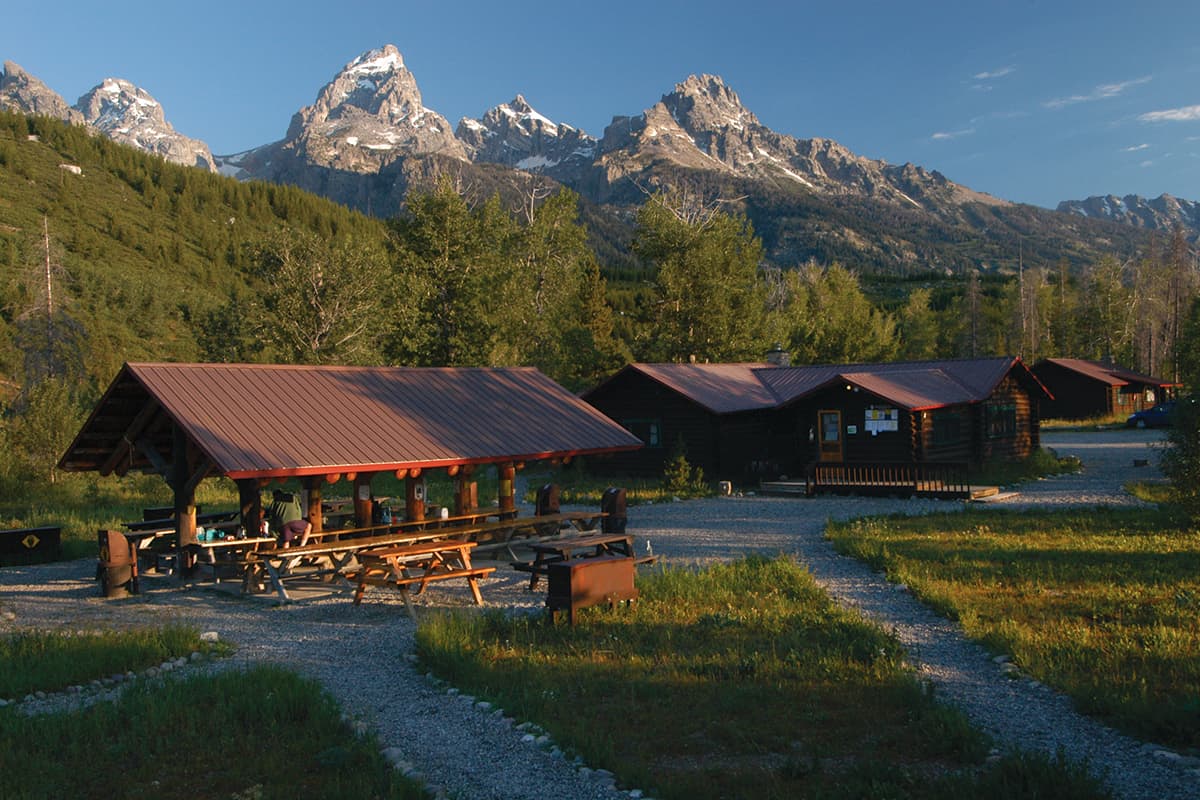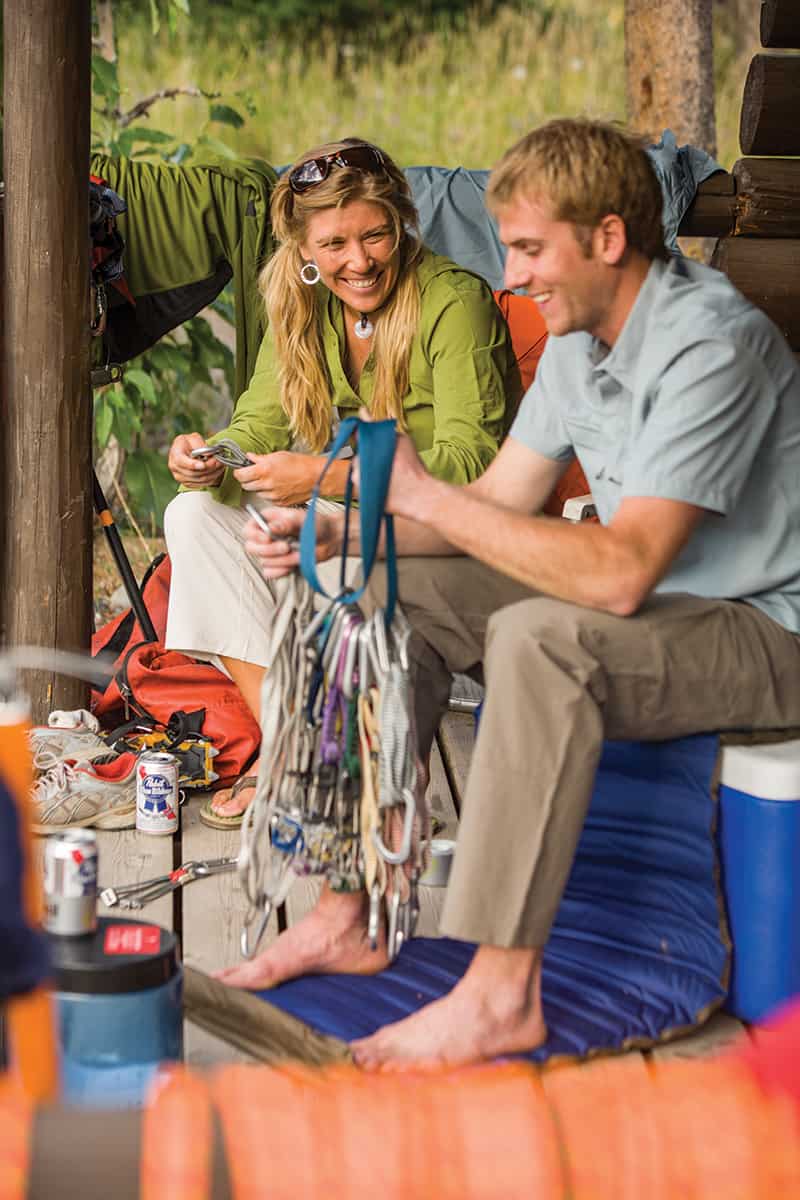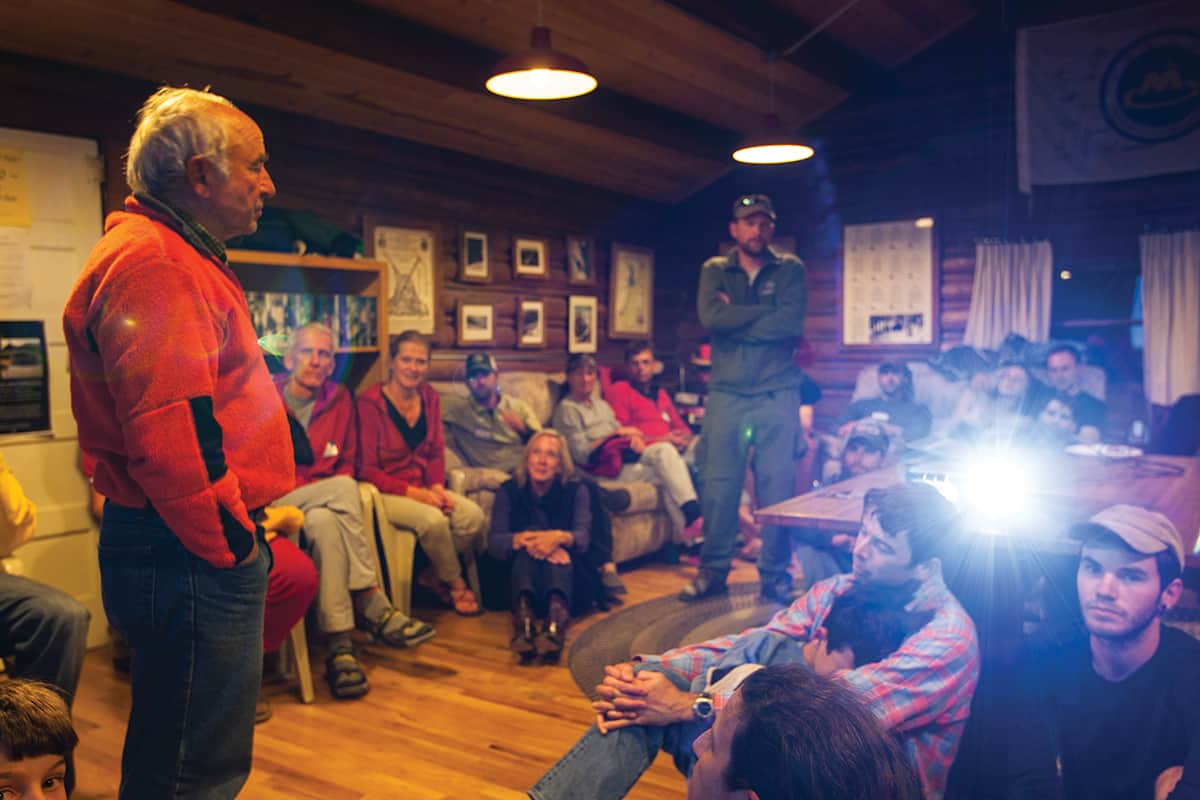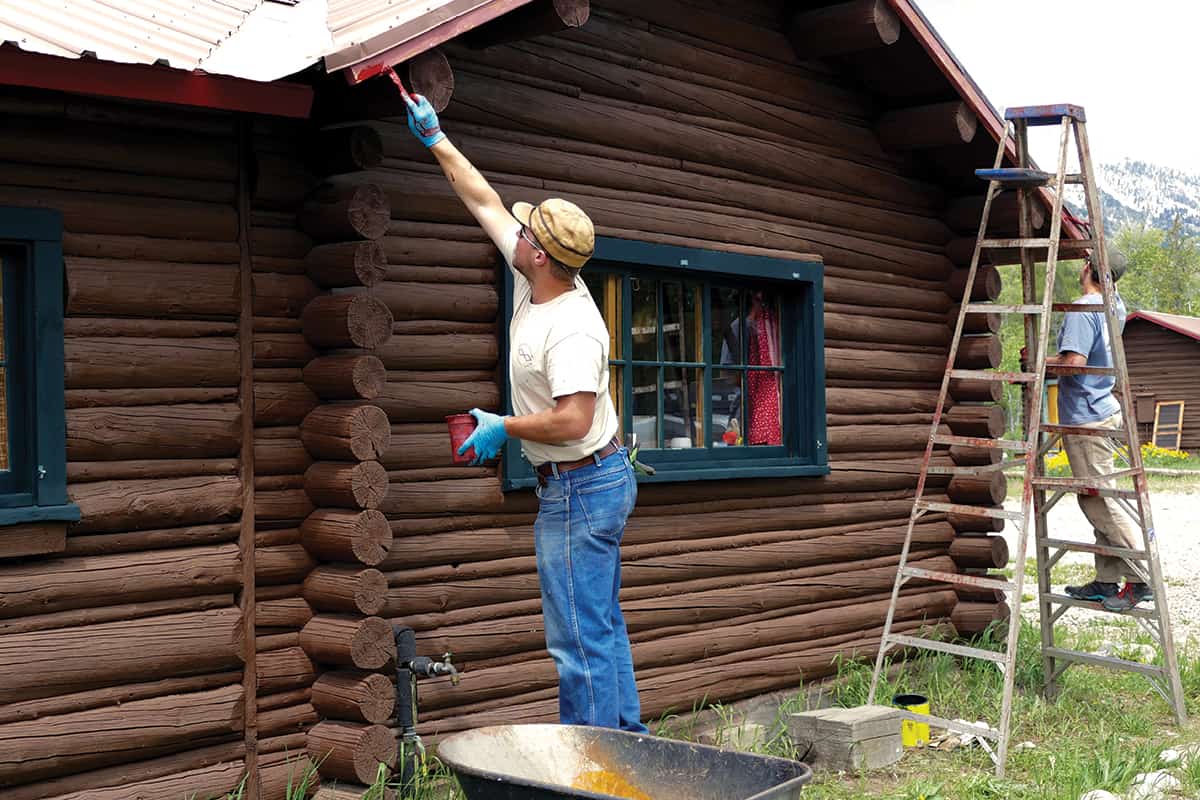Read The
Current Issue
Home Base
Although the Grand Teton Climbers’ Ranch is rich in climbing history (and personalities), you don’t need to be a climber to stay there.
By Geraldine Stal
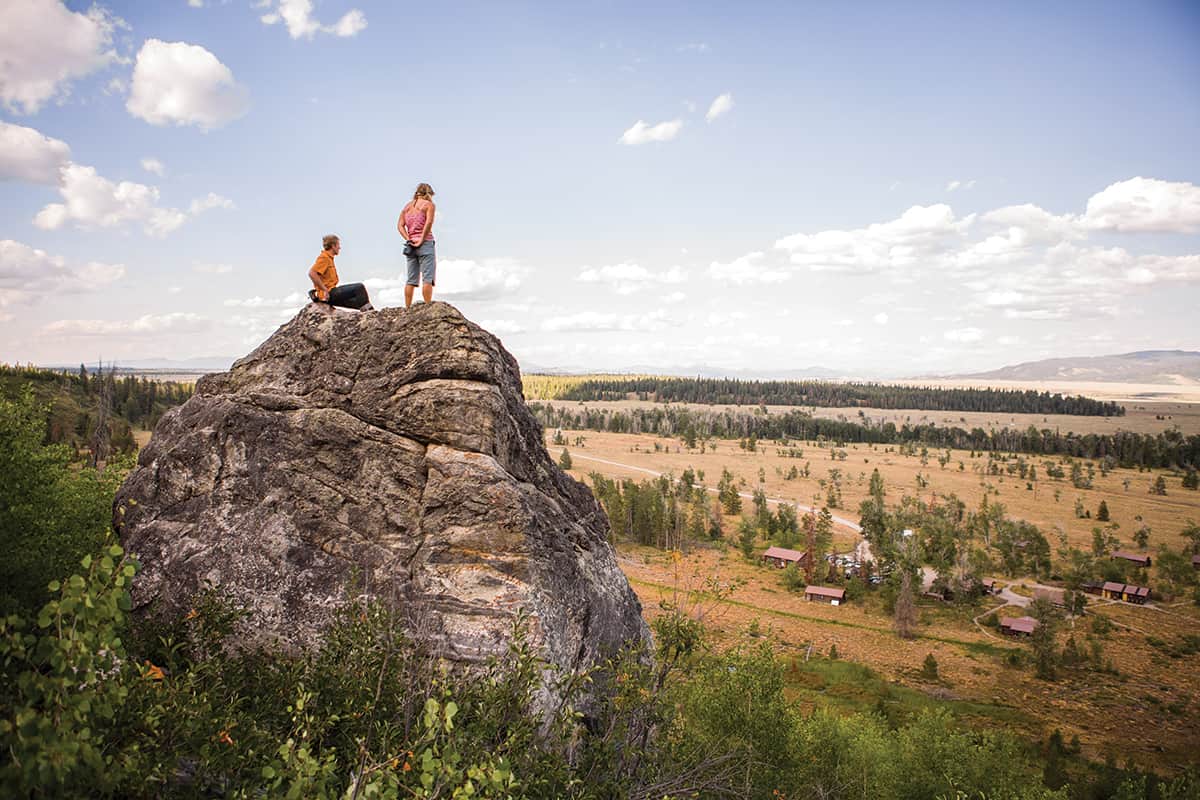
I MADE A fool of myself. Although I didn’t know it at the time. At the time—late last summer—I was sitting at a communal table beneath the cook shelter at the American Alpine Club’s (AAC) Grand Teton Climbers’ Ranch three miles south of Jenny Lake in Grand Teton National Park (GTNP), happily chatting with three long-time climbers. Every once in a while, I asked a question, but their stories and comments needed no prompting. They talked about routes; about hanging with some of the finest alpinists of the 1960s and ’70s, like Royal Robbins (who one of the three watched in a push-up contest) and Yvon Chouinard, who, in addition to founding the clothing company Patagonia, evidently has huge calves; about watching the wind pull the Exum Quonset hut on the Grand Teton’s Lower Saddle from its moorings and blowing it away; about hitchhiking with Glen Exum; about getting thrown out of the Jenny Lake Campground and/or the Climbers’ Ranch. The three men were like a guidebook come to life, with added firsthand accounts of climbing and hanging out with some of the sport’s legends.
It was later, after we all dispersed to our cabins—ten dorm-style, co-ed cabins, each with between four and six bunks, are found at the Climbers’ Ranch—that someone told me it was Steve Arsenault, Bob Horton, and Alan Nagel that I’d been visiting with. I got their first names while we chatted, but left out were their last names and climbing resumes. “Steve and Bob climbed hard,” my bunkmate said. Back home two days later, looking in my guidebook to the Wind River Mountains, I saw that Arsenault put up several terribly difficult first ascents on Raid and Ambush peaks in the East Fork Valley. Google informed me that he had established too many new routes to count in New England’s Mount Washington Valley, near his home. Horton has been climbing in the Tetons for almost fifty years and made plenty of his own first ascents.
“The first value the Climbers’ Ranch has for anyone, whether they’re a world-class climber or a duffer like myself, is the presence of a community of people who love the mountains and express that love through climbing. Other than Camp 4 in Yosemite, the Grand Teton Climbers’ Ranch is the only such place inside a national park in the country.”
– Bill Fetterhoff, chairman of the AAC’s Grand Teton Climbers’ Ranch
Nagel, who during our conversation described himself as “a duffer” in terms of climbing skills, never attained the technical level of Arsenault or Horton. But, over the last ten years he’s turned the Climbers’ Ranch library into one of the finest collections of mountaineering and climbing literature in the country and, in doing so, seems to have memorized each book in it, especially the ones having to do with the Tetons. When two twenty-somethings preparing themselves dinner under the cook shelter, who had just returned that afternoon from their first time climbing the Grand Teton, asked about “the giant black column” in the middle of the East Face of the Middle Teton, Nagel launched into details of the Black Dike Route, rated at a relatively easy 5.4. Then Horton, who has a Ph.D. in geology, talked about how it was formed.
Replaying the conversation after learning who I’d been talking to, I was embarrassed that I asked Arsenault if he had climbed Pingora, a classic in the Winds—and one that, in his day, he could have done blindfolded with a hand tied behind his back. But, by the time I curled into my sleeping bag on a top bunk in the Ortenburger North cabin, my embarrassment was replaced by wonder. I talked to these men for more than one hour, and, in a time when it seems everyone spews about how awesome they are (whether they are or not), they never once mentioned what amazing climbers they were. Instead, they chatted with me, and the several other youngish stragglers beneath the cook shelter, like we were their equals.
And that’s the point, says Bill Fetterhoff, chairman of the AAC Grand Teton Climbers’ Ranch committee since 2007.
GRAND TETON CLIMBERS’ Ranch opened in 1970 under a special use permit granted by the National Park Service (NPS). It was meant to be the successor to the Jenny Lake climbers’ camp, which had been used by Teton climbers from the 1950s until it was closed in 1966 because of friction between climbers and Park Service personnel. In 1968 in Pasadena, California, over Easter Sunday dinner, friends Nick Clinch, a lawyer, mountaineer, and then president of the American Alpine Club (AAC), and Horace Albright, a former head of the NPS, discussed the need for there to be a campground for climbers in Grand Teton National Park. Mountaineers from across the country came to the range to hone and test their skills on the Tetons’ solid, steep granite.
That summer, Clinch and Albright met in the park to look at potential sites, focusing on old dude ranches within the park’s boundaries. The top candidates were the former Double Diamond Ranch and the Half Moon Ranch. Both were dilapidated and hadn’t been used for several years. The Double Diamond, which first opened in 1924, was selected because the central peaks of the range—the Grand, Middle, and South Tetons, along with Teewinot Mountain, Nez Perce Peak, and Mount Owen—could be approached on trails directly from the ranch.
“If it wasn’t for Nick Clinch, we wouldn’t have the Climbers’ Ranch today.”
– Robert Hyman, climber and member of the Climbers’ Ranch Committee
“If it wasn’t for Nick Clinch, we wouldn’t have the Climbers’ Ranch today,” says Robert Hyman, a Washington D.C.-based climber and attorney who marked his twenty-seventh consecutive summer at the ranch last year. While Clinch secured the property, it was climbers and the first ranch manager, Dave Dornan, who made it habitable. “It was in very bad shape,” Fetterhoff says. “Yvon Chouinard [who founded Patagonia in 1973] lived there for the first two summers, working on repairing much of the plumbing. Many of the people who stayed there at the time helped out.”
In 1985 the Taggart Lake/Beaver Creek fire destroyed about half of the ranch’s buildings. In the office today, you can see what looks like an abstract metal sculpture hanging on the wall just before the door opening into the ranch manager’s kitchen. These are melted climbing nuts found after the fire had torn through the ranch.
After Dornan left as ranch manager—there has always been a manager and an assistant manager who live on site—Rick Liu took over. He was the manager when the fire came through. Next came Ruth Valsing, who was manager for ten years and retired to focus on teaching elementary school. She was followed by Paul Nash, who preceded Drew Birnbaum, who was followed by several managers who only lasted one season each. Bob Baribeau, who first visited the ranch in 1973, has been manager since 2016.
WHILE MANAGERS HAVE come and gone and the 1985 fire altered the landscape—“Before the fire, the whole ranch was in the woods,” Horton says—little else about the ranch has changed. And that’s the AAC’s goal. “I’ve made it my business to make sure it doesn’t [change],” Fetterhoff says. “My mission is to preserve its core values. The first value the Climbers’ Ranch has for anyone, whether they’re a world-class climber or a duffer like myself, is the presence of a community of people who love the mountains and express that love through climbing. Other than Camp 4 in Yosemite, the Grand Teton Climbers’ Ranch is the only such place inside a national park in the country.”
Fetterhoff says he and the AAC recognize the fundamental offering of the physical place: “a cheap bunk, a free shower with your bunk, and an unbeatable location with access to the high peaks.”
Fetterhoff says he and the AAC recognize the fundamental offering of the physical place: “a cheap bunk, a free shower with your bunk, and an unbeatable location with access to the high peaks.” That was the reason I stayed there. But, while these are indeed special, especially the location, “what climbers find here is a ready-made community of other like-minded people,” Fetterhoff says, “for whom, and with whom, they may either share the immediate experience of the mountains or they may acquire a lot of knowledge from other climbers. The cook shelter is like a classroom, and every night classes in advanced mountaineering are informally taught, cheerfully taught, and randomly taught.”
And, as I learned firsthand, also humbly taught. After I told Arsenault the East Fork Valley was one of the few major areas in the Winds I had yet to explore, he shared his favorite route into it. (Most of the first ascents he did were in the East Fork Valley.) “It’s about sixteen miles of hiking to get there and there are two ways,” he said. “But go via Boulder Lake. It’s less up and down.”
Fetterhoff tells a story about Alex Lowe, an Exum Guide and world-class mountaineer who was known as “The Mutant” for his climbing skills and strength until his death in 1999 at age forty in an avalanche on Tibet’s Shishapangma, one of only fourteen peaks in the world higher than 8,000 meters. “He lived in Cabin 3 at least one summer,” Fetterhoff says. “He wandered over to the cook shelter one night and listened as people talked about what they had done that day. He noticed that one person was being quiet and asked him what he had done that day. The guy responded, ‘I didn’t do anything, I just took a hike up to Amphitheater Lake.’ But Alex was like, ‘Wow, what a great day! What an experience!’ He knit that guy into the community. Over the years I’ve always noticed that the creation of a welcoming atmosphere is sort of a heritage of the place and [one that] has been carefully preserved.”
You do not need to be a climber or member of the AAC to stay at the Climbers’ Ranch, although the latter do get nightly discounts.
